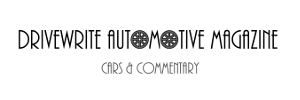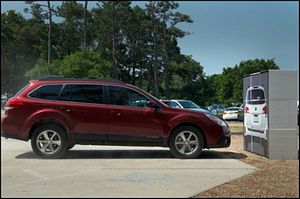|
By accessing or using The Crittenden Automotive Library™/CarsAndRacingStuff.com, you signify your agreement with the Terms of Use on our Legal Information page. Our Privacy Policy is also available there. |

Better Eyesight - Subaru Style
|
|---|
|
|
Better Eyesight - Subaru Style
Geoff Maxted
DriveWrite
September 27, 2013
Much has been made about automatic braking whereby a car will brake itself if it senses an imminent collision. This is a positive addition to safety that will help to prevent low speed shunts; minor repairs are expensive these days. It might even help to bring down the cost of car insurance although I shouldn’t hold your breath.
Right now Subaru are promoting their new EyeSight technology - a package of cameras and software that scans the road ahead for danger.
Twenty years in development apparently, this system has impressed the Insurance Institute for Highway Safety in the USA which gave both the Subaru Legacy and Outback top honours in its first ratings of automatic braking systems.
The new ratings, which will be used to select the IIHS Top Safety Pick+ winners for 2014, are a sign of how the safety battleground is shifting in the car industry now that automakers are focusing more heavily on software and sensors to keep their customers safe. In the tests, the Legacy and Outback detected a dummy car on the road and braked from 25 mph to a stop in time to avoid slamming into it. They were the only vehicles tested that came to a full stop, though five others slowed enough to win a ‘superior’ rating from the Institute.
An Institute spokesman said "Crash prevention technology is out there, and it's very promising, but it's also very confusing. We're going to do our best to untangle the confusion and encourage manufacturers to adopt what we know is working."
Because the IIHS was testing the vehicles' software and sensors, not their structural integrity, the group did not need to physically crash any cars. Instead, the vehicles were driven at a foam mock-up with a metal frame and vinyl cover that was designed to resemble a car to radar and image recognition software. It has a pocket for a number plate, because many systems look for that to differentiate a vehicle from, say, a rubbish bin.
Testing of automatic braking systems is complicated by the varying technology used by car manufacturers, and their differing philosophies on how it should work. Some want the vehicle to slam on the brakes fast and hard. Others are more wary of false alarms, so they hold back, delaying the automatic braking to avoid taking control away from the driver. EyeSight was found to work better than it said on the tin.
Subaru says EyeSight works up to a speed differential of 19 mph that is, when the difference between the Subaru and the vehicle in front of it is 19 mph or less, but IIHS testing found that it worked just fine at 25 mph. Subaru says it helps that EyeSight uses a stereo camera, while some systems rely more heavily on radar, which is less sophisticated, and less expensive.
Cars come loaded with technology these days and a lot of it is pointless or superfluous. Ultimately it remains to be seen how this well these systems work in the real world but as a safety (and potentially insurance claim saving) feature it is certainly a worthwhile option to consider.

















 Topics: Subaru
Topics: Subaru

